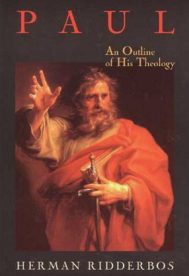FULLNESS OF TIME & NEW CREATION
 PMW 2023-063 by Herman Ridderbos
PMW 2023-063 by Herman Ridderbos
GENTRY INTRODUCTION
The following material is taken from Ridderbos’ important work: Paul: An Outline of His Theology (pp. 44ff). Some of his footnotes have been omitted as unnecessary for my present concern. I highly recommend that my readers study Herman Ridderbos, Geerhardus Vos, and Richard B. Gaffin, Jr. as insightful biblical scholars (even though they are amillennial).
RIDDERBOS EXPLICATION
The extent . . . to which Paul saw the advent and work of Christ as revelation of the fulfilling activity of God in history and as the breaking through of the great time of salvation can immediately be demonstrated on the basis of a number of typical pronouncements from his epistles.
Galatians 4:4
What is said in Galatians 4:4 of “the fullness of the time” and in Ephesians 1:10 of “the fulness of the times” is surely of special important:
“but when the fullness of the time came, God sent forth his Son.”
“the mystery of his [God’s] will …, unto a dispensation of the fullness of the times, to sum up all things in Christ, the things in the heavens, and the things upon earth.”
What is meant by this “fullness of the time” is not only the maturation of a specific matter in the great framework of redemptive history, but the fulfillment of the time in an absolute sense. The time of the world has come by a conclusion with Christ’s advent. However much this fulfillment still bears a provisional character and the perfectum is followed yet again by a futurum, nevertheless the pleroma of the time or of the times is here spoken of as a matter that has already taken effect and thus in principle has been settled.
The Early Date of Revelation and the End Times: An Amillennial Partial Preterist Perspective
By Robert Hillegonds
This book presents a strong, contemporary case in support of the early dating of Revelation. He builds on Before Jerusalem Fell and brings additional arguments to bear.
See more study materials at: www.KennethGentry.com
2 Corinthians 6:2
This commencement of the great time of salvation is no less clearly attested in 2 Corinthians 6:2, where the apostle as with finger extended points to its presence: “Behold, now is the acceptable time; now is the day of salvation!”
Here, too, what is to be understood by “the acceptable time” and “the day of salvation” is not merely a certain saving event or opportunity that one must embrace and which may perhaps presently disappear again. Nothings less is intended than that the decisive, long-expected coming of God has dawned, the hour of hours, the day of salvation in the fulfilling, eschatological sense of the word. This is apparent as well from the preceding context where Paul writes of the great change that has entered with the death and resurrection of Christ as follows: “Wherefore if any man is in Christ , he is a new creation; the old things have passed away; behold, the new have come” (2 Cor. 5:17).
2 Corinthians 5:17
When he speaks here of “new creation,” this is not meant merely in an individual sense (“a new creature”), but one is to think of the new world of the re-creation that God has made to dawn in Christ, and in which everyone who is in Christ is included. This is also evident from the neuter plural that follows: “the old things have passed away, the new have come,” and from the full significance that must be ascribed here to “old” and “new.” It is a matter of two worlds, not only in a spiritual, but in a redemptive-historical, eschatological sense. The “old things” stand for the unredeemed world in its distress and sin, the “new things” for the time of salvation and the re-creation that have dawned with Christ’s resurrection. He who is in Christ, therefore, is new creation: he participates in, belongs to, this new world of God. [n. 1]
The “mystery”
The qualification of this event as the “revelation of the mystery,” or, the “making known” of that which until now was “kept secret” or “hidden,’ for which the apostle has a predilection, is also indicative of this eschatological character of the redemptive dispensation that has dawned in Christ and of its proclamation by Paul. What a dominant place this expression occupies throughout all of Paul’s epistles may appear from the following [verses: Rom. 16:25, 26; Col. 1:26; cf. 2:2, 3; Eph. 1:9, 10; Eph. 3:4, 5; cf. v. 3; 1 Cor. 2:7; 2 Tim. 1:9, 10; cf. also Tit. 1:2, 3] [n. 2]

Covenantal Theonomy
(by Ken Gentry)
A defense of theonomic ethics against a leading Reformed critic. Engages many of the leading objections to theonomy.
See more study materials at: www.KennethGentry.com
The attempt has often been made to understand “mystery” by analogy with the significance of this word in the ancient mystery religions in the sense of a kind of secret teaching that is “revealed” to only a few intimates. In Paul, however, it has a completely different sense, as is apparent also from a comparison with newly unlocked Jewish sources [i.e., from Qumran]: “mystery,” that which has been “hidden,” is to be understood, as a few of the texts cited say in so many words, in connection with the hidden counsel of God in relation to his redemptive work in history. “Hiddenness,” ‘mystery,” etc., has, therefore, in addition to a noetic a plainly historical connotation: it is that which has not yet appeared, that which still exists in the counsel of God and has not yet been realized in history as fulfillment of that counsel.
Accordingly the corresponding word “reveal” not only means the divulging of a specific truth or the giving of information as to certain events or facts, but the appearance itself, the becoming historical reality of that which until now did not exist as such, but was kept by God, hidden, held back. As such, namely, as the realized redemptive plan of God, this mystery is consequently the object of Paul’s proclamation and of the revelation of God to his saints and so forth.
From the way in which this expression — certainly very characteristic for Paul — is used, the eschatological nature of the content of his preaching is apparent once again. For this mystery has reference to the purpose of God with a view to the fullness of the times (Eph. 1:9, 10). Standing over against the “kept secret for long ages,” “hidden for ages and generations,” etc., is again and again the “now” of the revelation, the end of the waiting ages, the ultimate intervention of God according to his counsel and promise. What is here called in various nuances the revelation of the mystery is nothing other than that which the fullness of the time brings to view; it is the fulfillment of the eschatological promise of redemption in the times appointed for it, its “own times,’ that is denoted in this fashion.”
NOTES
1. That ktisis here does not simply mean “creature” in the sense of individual man or being, but must be understood in the full sense as the new life called forth by God’s omnipotence, is clearly evident form a comparison with such passages as Eph. 2:10, 15; 4:24; Col. 3:10; cf. also Foerster in TDNT, III, p. 1034, s.v. ktizo. To the same effect G. Vos, The Pauline Eschatology, 1930, pp. 46, 47: “…not merely individual, subjective conditions have been changed, but …. there has been created a totally new environment, or, more accurately speaking: a totally new world, in which the person spoken of is an inhabitant and participator.”
2. Gentry editorial note: Instead of printing out the verses, as in Ridderbos’ book, I have simply listed the verses that he presents.
Click on the following images for more information on these studies:



Kenneth L. Gentry Jr.'s Blog
- Kenneth L. Gentry Jr.'s profile
- 85 followers



